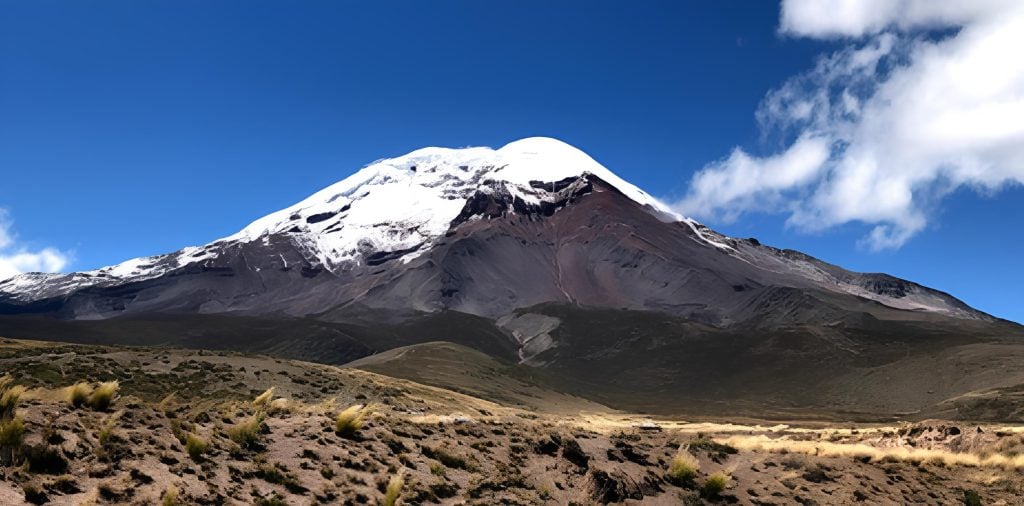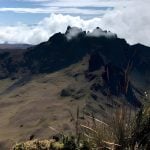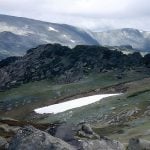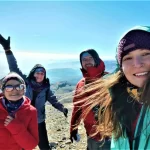Mount Chimborazo : The Closest Point to the Sky
One of the most impressive mountains in South America, Chimborazo Mountain is the highest peak in Ecuador and a stunning summit of the Andes. Standing at 6,263 meters, this volcanic mountain is not only the tallest in Ecuador but also one of the most unique peaks in the world. Mount Chimborazo : The Closest Point to the Sky
The Unique Location of Chimborazo Mountain
What sets Chimborazo apart from other mountains is its distance from the Earth’s center. Due to its location near the equator, Chimborazo’s summit is farther from the Earth’s core than Everest. This makes it the farthest point from the Earth’s center on the planet.
Climbing Chimborazo: Challenges and Routes
Although not the most technically difficult mountain, Chimborazo presents challenges due to its altitude and rapidly changing weather conditions, making it suitable for experienced climbers. The most popular route is the Whymper Route, first successfully climbed by Edward Whymper in 1880. Today, this route remains the preferred path for mountaineers.
The ascent usually takes two days. On the first day, climbers reach Refugio Carrel (4,850 m) or Refugio Whymper (5,000 m). The summit push begins overnight, requiring climbers to traverse glaciers. Proficiency in crampon, ice axe, and rope techniques is essential.
Best Time to Climb Chimborazo
The best seasons to climb Chimborazo are June – August and December – January, when weather conditions are relatively stable and glaciers are safer. However, due to the equatorial climate, the weather can change drastically within hours, making a reliable forecast crucial.
Essential Equipment for Climbing Chimborazo
Proper high-altitude mountaineering gear is essential for a successful climb. Here’s a checklist of key equipment:
- Crampons and ice axe
- Ropes and safety equipment
- High-altitude boots and thermal clothing
- Helmet and goggles (to protect against snow blindness)
- GPS or map & compass
- Plenty of water and high-energy food
The Natural Beauty of Chimborazo
Chimborazo is not just for climbers—it’s also a paradise for nature lovers. At the base of the mountain, you can spot herds of vicuñas (wild relatives of llamas). The mountain is part of Reserva de Producción Faunística Chimborazo, one of Ecuador’s largest nature reserves. The breathtaking sunrise and sunset views make it a dream destination for photographers.
How to Get to Chimborazo Mountain
To reach Chimborazo, the first step is traveling to Riobamba from Quito or Guayaquil. From Riobamba, it’s about a two-hour drive to the entrance of the mountain. Many climbers stay in Riobamba for acclimatization before attempting the ascent.
Conclusion
Chimborazo holds a special place in mountaineering as a peak that is both technically and geographically remarkable. If you are looking to experience high-altitude climbing, conquer one of the tallest summits in the Andes, and stand on the farthest point from Earth’s center, then Chimborazo should be on your bucket list!
Where is Chimborazo Mountain located?
Chimborazo is located in Ecuador, in the Andes mountain range, near the city of Riobamba.
How high is Chimborazo?
Chimborazo stands at 6,263 meters (20,548 feet) above sea level.
Why is Chimborazo considered the farthest point from the Earth’s center?
Due to the Earth’s equatorial bulge, Chimborazo’s summit is farther from the Earth’s core than Mount Everest’s summit.
Is climbing Chimborazo difficult?
Yes, climbing Chimborazo is challenging due to its high altitude, unpredictable weather, and glacier-covered slopes.
What is the best time to climb Chimborazo?
The best climbing seasons are from June to August and from December to January when weather conditions are more stable.
Do I need a guide to climb Chimborazo?
Yes, hiring a certified guide is highly recommended due to the technical difficulty and risks involved.
What kind of wildlife can be seen around Chimborazo?
You can spot vicuñas, llamas, and Andean condors in the Chimborazo Faunistic Reserve.
What equipment is necessary for climbing Chimborazo?
Essential gear includes crampons, ice axes, ropes, high-altitude boots, thermal clothing, and a helmet.
How can I acclimatize before climbing Chimborazo?
Spending a few days at high altitudes, such as in Riobamba or nearby mountains, helps in acclimatization.
How do I get to Chimborazo from Quito?
You can travel from Quito to Riobamba by bus or car, and then take a two-hour drive to the base of the mountain.





